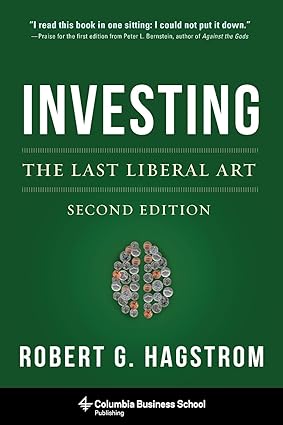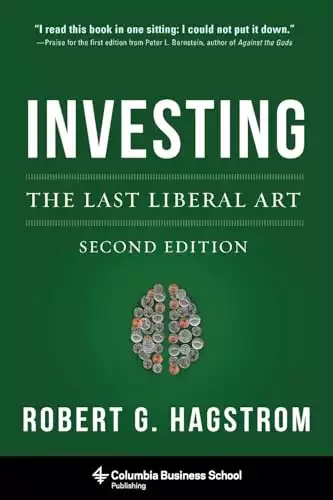Overview : Investing: The Last Liberal Art
- Book Title: Investing: The Last Liberal Art
- Author: Robert G. Hagstrom
- Publication Date: First published in 2000
- price: $23.56
- Pages: 216
Overview of the Book
Robert G. Hagstrom is a renowned author and investment strategist, best known for his New York Times best-seller, The Warren Buffett Way, which has sold over a million copies. He serves as the chief investment strategist at Legg Mason Investment Counsel.
Introduction
In the ever-evolving world of finance and investing, Robert G. Hagstrom's "Investing: The Last Liberal Art" stands out as a thought-provoking masterpiece that challenges conventional wisdom. Published in 2000, this book offers a fresh perspective on investing by intertwining it with various disciplines, positioning it as a multifaceted liberal art rather than a mere financial skill.
Book Summary
Hagstrom's central thesis revolves around the idea that successful investing requires more than just number-crunching and market analysis. He argues that a holistic approach, incorporating knowledge from diverse fields such as psychology, biology, physics, and philosophy, is essential for making informed investment decisions. The book is structured into chapters exploring different disciplines and their relevance to investing:
- Psychology: Examines cognitive biases and emotional pitfalls affecting investor behavior
- Biology: Draws parallels between natural selection and market competition
- Physics: Applies concepts like chaos theory to understand market unpredictability
- Philosophy: Emphasizes critical thinking and ethical considerations in investment decisions
Hagstrom introduces the concept of "the latticework of mental models," borrowed from renowned investor Charlie Munger, which advocates for understanding the world through interconnected concepts spanning various disciplines.
Analysis of Themes
Interdisciplinary Approach to Investing
The book's core strength lies in its ability to seamlessly integrate diverse fields into a cohesive investment framework. This approach aligns well with current market trends, where factors beyond traditional financial metrics increasingly influence asset values.
Psychological Aspects of Investing
Hagstrom's exploration of cognitive biases in investing is particularly relevant in today's information-rich environment. Understanding concepts like loss aversion and herd mentality can help investors navigate the complexities of modern markets, including the volatile world of cryptocurrencies.
Adaptability in Investing
The biological analogy of adaptation in market competition resonates strongly with the current rapidly changing financial landscape. This perspective is crucial for investors dealing with emerging asset classes and evolving market structures.
Writing Style
Hagstrom's writing is accessible yet intellectually stimulating. He skillfully breaks down complex concepts, making them digestible for readers without extensive backgrounds in the discussed fields. The book is enriched with anecdotes and real-world examples, enhancing its practical relevance.
Strengths and Weaknesses
Strengths:
- Unique interdisciplinary perspective on investing
- Encourages critical thinking and broad-based learning
- Relevant to both novice and experienced investors
- Promotes long-term, thoughtful investment strategies
Weaknesses:
- Lack of specific, actionable investment strategies
- May be too abstract for readers seeking practical tips
- Published in 2000, some examples may feel dated
Comparison to Other Works
While many investment books focus on specific strategies or market analysis, "Investing: The Last Liberal Art" stands out for its broader, more philosophical approach. It shares similarities with works like Peter Lynch's "One Up On Wall Street" in emphasizing the importance of understanding businesses beyond numbers, but takes this concept further by incorporating non-financial disciplines. Compared to more recent works like "The Psychology of Money" by Morgan Housel, Hagstrom's book offers a wider interdisciplinary scope, though it may lack some of the up-to-date behavioral finance insights found in newer publications.
Highlights from Investing: The last liberal art
- Interdisciplinary approach: Explores how various fields like history, psychology, and mathematics influence investing.
- Critical thinking: Emphasizes the importance of broad knowledge in making sound investment decisions.
- Behavioral economics: Highlights how human behavior affects market outcomes.
- Mental models: Advocates using diverse mental frameworks to understand complex financial scenarios.
- Long-term perspective: Encourages patience and careful analysis over short-term speculation.
- Learning from failure: Stresses the value of mistakes and continuous learning in investing.
Conclusion
Robert G. Hagstrom's "Investing: The Last Liberal Art" is a timeless piece that offers a unique perspective on investing. By framing investing as a liberal art, Hagstrom encourages readers to develop a multifaceted understanding of the world, which can lead to more informed and thoughtful investment decisions. While it may not provide specific investment strategies, the book's value lies in its ability to broaden the reader's perspective and foster critical thinking. In today's complex financial landscape, where personal finance intertwines with global market trends and emerging technologies like cryptocurrencies, Hagstrom's interdisciplinary approach is more relevant than ever. For investors looking to deepen their understanding of the markets and develop a more holistic approach to investing, "Investing: The Last Liberal Art" is an invaluable resource. It challenges readers to think beyond traditional financial metrics and consider the broader context of their investment decisions.
"Investing is not the study of finance. It's the study of how people behave with money." - Robert G. Hagstrom





